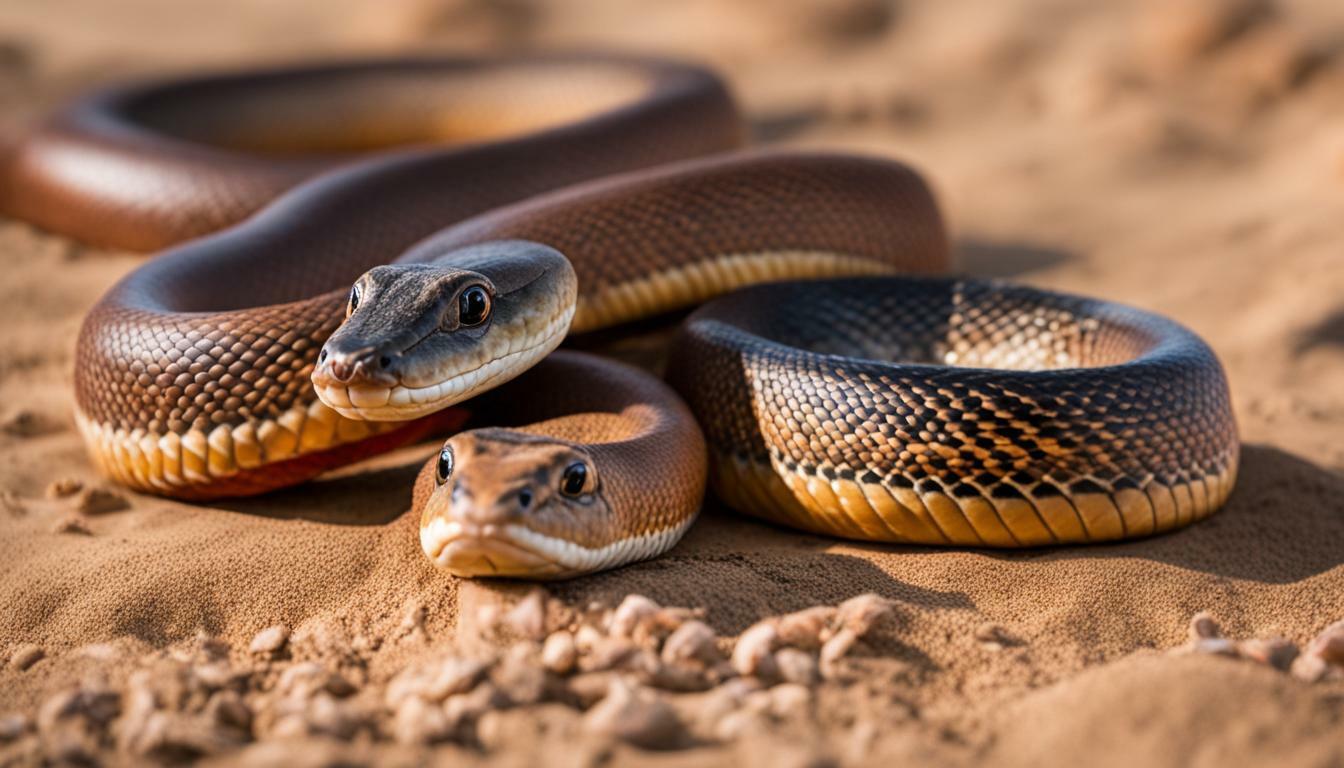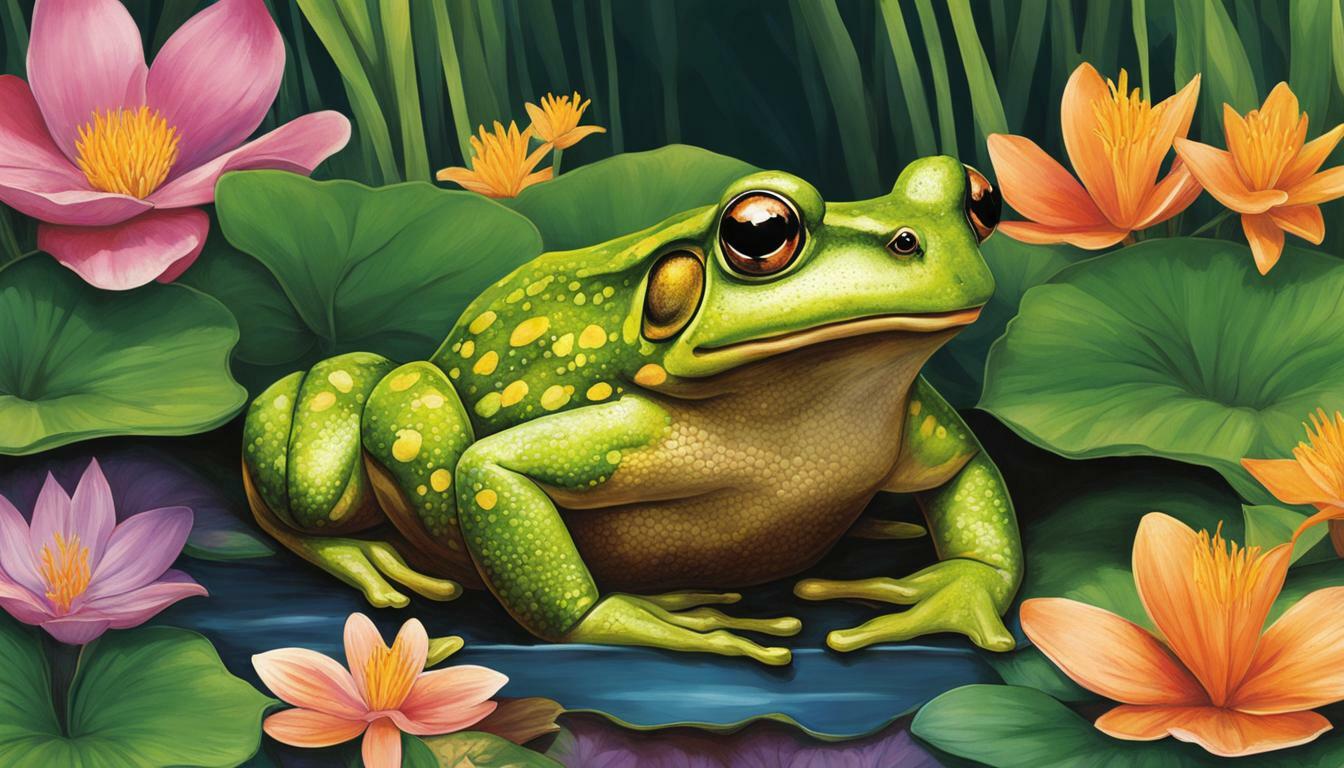Sand boas and rosy boas are fascinating snake species that share similar adaptations to their environments, but there are several key differences between them. Both species are excellent choices for snake keepers, especially those with limited space. The rosy boa is native to deserts and arid scrublands in Southern California, southwestern Arizona, Baja California, and Sonora, Mexico. There are three subspecies of rosy boas with variations in color and pattern. Sand boas, on the other hand, are found in deserts and arid scrub habitats in Africa, South Asia, and the Middle East. The Egyptian and Kenyan sand boas are the most commonly kept species. Both sand boas and rosy boas are highly specialized burrowers and spend most of their time below ground. They prefer to live alone and have specific humidity and temperature requirements in their habitats. Sand boas must be given a deep substrate of smooth-grained sand in which to burrow, while a mix of smooth sand and aspen bedding works well for rosy boas. Both species require heat and a thermal gradient in their enclosures. Rosy and sand boas are generally inoffensive and relatively easy to handle, but sand boas may become stressed when removed from their subterranean hiding places. Both species readily accept pre-killed prey, such as fuzzies or small mice. Overall, rosy boas and sand boas are unique and fascinating snake species that can thrive in smaller enclosures with the proper care.
Key Takeaways:
- Sand boas and rosy boas are unique snake species that share similar adaptations to their environments.
- Rosy boas are native to deserts and arid scrublands in Southern California, southwestern Arizona, Baja California, and Sonora, Mexico.
- Sand boas are found in deserts and arid scrub habitats in Africa, South Asia, and the Middle East.
- Rosy boas have three subspecies with variations in color and pattern.
- Sand boas require a deep substrate of smooth-grained sand, while rosy boas do well with a mix of smooth sand and aspen bedding.
- Both species have specific humidity and temperature requirements in their habitats.
- Sand boas and rosy boas are burrowers and spend most of their time below ground.
Sand Boa Characteristics
Sand boas are native to deserts and arid scrub habitats in Africa, South Asia, and the Middle East, and they have unique adaptations that allow them to thrive in these environments. These small to medium-sized snakes are known for their stout bodies and short tails, which enable them to move through loose sand with ease. Additionally, their eyes are positioned on the top of their heads, allowing them to remain partially buried while keeping an eye out for prey or potential predators.
One of the most intriguing characteristics of sand boas is their ability to burrow. They possess specialized scales on their belly called “scutes,” which help them maneuver through the sand. These snakes spend the majority of their time below ground, emerging at night to hunt for small rodents and other prey. Sand boas have a unique feeding behavior known as “ambush predation,” where they patiently wait for prey to pass by before striking with lightning speed.
In terms of appearance, sand boas exhibit a wide range of colors and patterns, making them visually striking. Some popular color morphs include albino, anerythristic, and snow. These variations in coloration have made sand boas a sought-after species among snake enthusiasts. They are relatively docile and can be easily handled, making them a great choice for beginner snake keepers. However, it’s important to note that sand boas may become stressed when removed from their subterranean hiding places, so gentle handling is recommended.
| Key Characteristics of Sand Boas | |
|---|---|
| Native Habitat | Deserts and arid scrublands in Africa, South Asia, and the Middle East |
| Special Adaptations | Stout bodies, short tails, eyes positioned on the top of their heads, scutes on their belly |
| Feeding Behavior | Ambush predation – patiently waiting for prey and striking with speed |
| Appearance | Wide range of colors and patterns, popular morphs include albino, anerythristic, and snow |
| Temperament | Relatively docile and easy to handle, but may become stressed when removed from hiding places |
With the right care, sand boas can thrive in captivity. Their enclosures should feature a deep substrate of smooth-grained sand, allowing them to exhibit their natural burrowing behavior. Providing appropriate temperature and humidity levels is crucial for their overall well-being. Sand boas require a basking spot with temperatures reaching around 90°F (32°C), while the cooler end of the enclosure should have temperatures around 75°F (24°C). They also need a thermal gradient to regulate their body temperature effectively.
Overall, sand boas are captivating creatures with their unique adaptations, striking appearance, and burrowing behavior. They are a fantastic choice for snake enthusiasts looking to keep a captivating and low-maintenance species.
Rosy Boa Characteristics
Rosy boas are indigenous to deserts and arid scrublands in Southern California, southwestern Arizona, Baja California, and Sonora, Mexico, and they exhibit distinct traits that set them apart from other snake species. These beautiful snakes are known for their docile nature, making them suitable pets for beginners and experienced snake enthusiasts alike. They have an average adult size of 2 to 4 feet, with some individuals reaching up to 5 feet in length.
One of the fascinating features of rosy boas is their ability to produce a wide range of colors and patterns. There are three subspecies of rosy boas: the coastal, desert, and rubber boa. Each subspecies has its own unique appearance, with variations in body color, pattern, and scale texture. The coastal rosy boa, for example, typically has a light brown or tan base color with dark brown or black markings, while the desert rosy boa often has a lighter coloration with reddish-brown or orange hues.
Rosy boas are avid burrowers, spending a significant amount of their time underground. They are well adapted to their desert habitat, with reduced heat and water loss through their scales. These snakes have a gentle disposition and are generally easy to handle, making them popular pets. However, it’s important to note that they may become stressed when removed from their subterranean hideouts, so gentle and patient handling is recommended.
In their natural habitat, rosy boas primarily feed on small mammals, including mice, rats, and lizards. They are constrictor snakes, using their muscular bodies to wrap around their prey and suffocate them. In captivity, rosy boas readily accept pre-killed prey, such as fuzzies or small mice, making them relatively easy to feed.
Rosy Boa Characteristics at a Glance:
| Trait | Description |
|---|---|
| Native Habitat | Deserts and arid scrublands in Southern California, southwestern Arizona, Baja California, and Sonora, Mexico |
| Size | 2 to 4 feet in length |
| Appearance | Varies by subspecies, with unique color and pattern variations |
| Behavior | Gentle and docile, but may become stressed when handled |
| Diet | Primarily small mammals, such as mice and rats |
Rosy boas are highly adaptable snake species that can thrive in smaller enclosures with the proper care. Their unique characteristics and stunning appearance make them a sought-after choice among snake keepers.
Sand Boa Care and Feeding
To ensure the well-being of sand boas, it’s essential to provide them with a deep substrate of smooth-grained sand for burrowing and maintain appropriate heat and humidity levels in their enclosures. These fascinating snakes are highly specialized burrowers, spending most of their time below ground. Creating a suitable habitat that mimics their natural environment is crucial for their overall health and happiness.
When setting up the enclosure for your sand boa, make sure to provide a layer of sand that is deep enough for them to bury themselves completely. This allows them to exhibit their natural digging behavior and feel secure in their environment. Smooth-grained sand without sharp edges is preferred to prevent any injuries to their delicate skin.
Heat and humidity are also vital factors to consider when caring for sand boas. They require a warm side of the enclosure with a temperature gradient ranging from 85-90°F (29-32°C) during the day and a cooler side ranging from 75-80°F (24-27°C). This allows them to thermoregulate by choosing their preferred temperature. A heat pad placed under one side of the tank or a ceramic heat emitter can provide the necessary warmth.
In terms of humidity, sand boas thrive in environments with moderate levels of humidity, ranging from 40-60%. Maintaining proper humidity can be achieved by misting the enclosure with water or providing a humid hide. This is especially important during shedding periods, as higher humidity helps the snakes shed their skin more easily.
When it comes to feeding, sand boas are carnivorous and primarily eat small prey such as fuzzies or small mice. It is recommended to feed them pre-killed prey to prevent any injuries that might occur during live feeding. The size of the prey should be proportionate to the size of the sand boa, ensuring that it can be swallowed without any difficulties.
| Key Care Requirements for Sand Boas |
|---|
| Deep substrate of smooth-grained sand |
| Appropriate temperature gradient: 85-90°F (29-32°C) on the warm side and 75-80°F (24-27°C) on the cool side |
| Moderate humidity levels of 40-60% |
| Pre-killed prey such as fuzzies or small mice |
Providing sand boas with the care they require will ensure their optimal well-being. With the right substrate, temperature, humidity, and feeding routine, these unique snakes can thrive in smaller enclosures, making them an ideal choice for snake enthusiasts with limited space.
Rosy Boa Care and Feeding
Providing rosy boas with a mix of smooth sand and aspen bedding, along with proper heating and lighting, is crucial for their overall health and well-being. These unique snake species require specific care to thrive in captivity.
When setting up their enclosure, it is important to create a suitable environment that mimics their natural habitat. A mix of smooth sand and aspen bedding provides a comfortable substrate for rosy boas to burrow and hide. This allows them to exhibit their natural behavior and feel secure.
Heat is an essential aspect of rosy boa care. A temperature gradient should be provided within the enclosure, with a cooler side ranging between 75-80°F (24-27°C) and a warmer side around 85-90°F (29-32°C). This allows rosy boas to regulate their body temperature by moving between different temperature zones.
In terms of feeding, rosy boas are generally easy to care for, as they readily accept pre-killed prey. Fuzzies or small mice are suitable food choices for adult rosy boas. It is important to feed them appropriately-sized prey to prevent any digestive issues. Feeding should take place on a regular schedule, usually every 7-10 days.
Overall, providing proper care, a suitable environment, and a balanced diet are essential for the health and well-being of rosy boas. With their unique characteristics and relative ease of care, these fascinating snake species can thrive in smaller enclosures with the right conditions.
Conclusion
In conclusion, while sand boas and rosy boas share some similarities in their adaptations and lifestyles, they also have distinct differences in terms of their natural habitats, appearance, and specific care needs. Sand boas are commonly found in deserts and arid scrub habitats in Africa, South Asia, and the Middle East, with the Egyptian and Kenyan sand boas being the most commonly kept species. On the other hand, rosy boas are native to deserts and arid scrublands in Southern California, southwestern Arizona, Baja California, and Sonora, Mexico.
Another noticeable difference between the two species is their physical characteristics. While sand boas typically have shorter and stockier bodies, rosy boas have a slenderer build. Additionally, rosy boas have three distinct subspecies with variations in color and pattern, adding to their visual appeal.
When it comes to care, both sand boas and rosy boas have specific requirements that need to be met. Sand boas, being highly specialized burrowers, require a deep substrate of smooth-grained sand in their enclosures. On the other hand, a mix of smooth sand and aspen bedding works well for rosy boas. Both species also require heat and a thermal gradient in their habitats to regulate their body temperature effectively.
While sand boas and rosy boas are generally inoffensive and relatively easy to handle, it is important to note that sand boas may become stressed when removed from their subterranean hiding places. Both species readily accept pre-killed prey, such as fuzzies or small mice, making feeding relatively straightforward.
Overall, sand boas and rosy boas are unique and fascinating snake species that can thrive in smaller enclosures with the proper care. Whether you prefer the stockier build of the sand boa or the slender beauty of the rosy boa, both species offer snake keepers the opportunity to experience the wonders of these remarkable creatures.
FAQ
What is the difference between sand boas and rosy boas?
Sand boas and rosy boas are two unique snake species that have similar adaptations to their environments. Sand boas are found in deserts and arid scrub habitats in Africa, South Asia, and the Middle East, while rosy boas are native to deserts and arid scrublands in Southern California, southwestern Arizona, Baja California, and Sonora, Mexico.
What are the characteristics of sand boas?
Sand boas are highly specialized burrowers and spend most of their time below ground. They require a deep substrate of smooth-grained sand in which to burrow. Sand boas prefer to live alone and have specific humidity and temperature requirements in their habitats. They may become stressed when removed from their subterranean hiding places.
What are the characteristics of rosy boas?
Rosy boas are also highly specialized burrowers and spend most of their time below ground. They prefer to live alone and require a mix of smooth sand and aspen bedding in their enclosures. There are three subspecies of rosy boas with variations in color and pattern.
How do I care for sand boas?
Sand boas require specific care to thrive. They need a deep substrate of smooth-grained sand, a thermal gradient in their enclosure, and a specific humidity level. They readily accept pre-killed prey, such as fuzzies or small mice, for feeding.
How do I care for rosy boas?
Rosy boas have specific care requirements. They need a mix of smooth sand and aspen bedding in their enclosures, a thermal gradient for regulating their body temperature, and proper humidity levels. Like sand boas, they readily accept pre-killed prey for feeding.
Source Links
- https://ball-pythons.net/forums/showthread.php?54996-Rosy-or-Kenyan-Sand-Boa-Which-should-I-get
- http://blogs.thatpetplace.com/thatreptileblog/2012/06/27/rosy-boa-and-sand-boa-captive-care-and-natural-history/
- https://www.petsmart.com/learning-center/reptile-care/a-set-up-guide-for-new-sand-boa-or-rosy-boa-pets/A0137.html
 Skip to main content
Skip to main content


